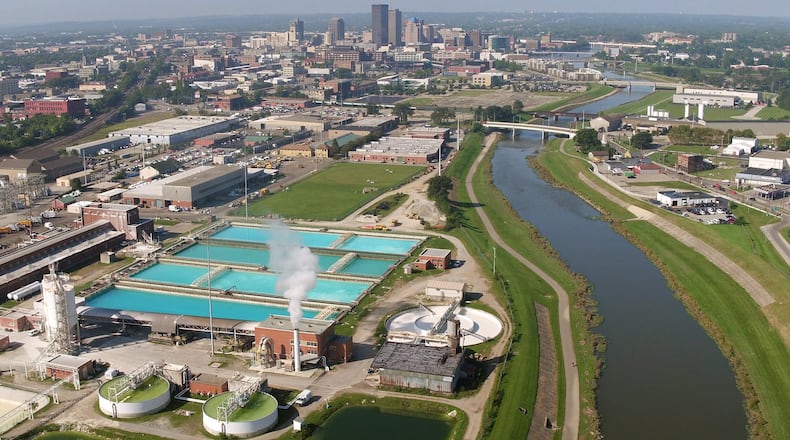The defendants named in the suit are 3M Company, Minnesota Mining and Manufacturing Co., Buckeye Fire Equipment Company, Chemguard Inc., Tyco Fire Products L.P., and National Foam Inc.
The city seeks to recover past and future damages for the remediation of PFAS, formally known as Per- and Polyfluoroalkyl Substances used in some firefighting foams.
While fire retardant is believed to be the source of PFAS in Dayton’s water, precisely where the contamination originated is unknown. The compounds were both used during training at Wright-Patterson Air Force Base and the Dayton Fire Training Center on McFadden Avenue.
About 1,500 drinking water systems across the country serving roughly 110 million Americans may be contaminated by PFAS, according to a recent analysis by the Environmental Working Group. About 400,000 people in this area get their drinking water from Dayton wells either through the city’s distribution system or one operated by Montgomery County.
Our Coverage
Clean water is an abundant and vital resource for the entire region. We continue to cover the effects of contaminants to the Great Miami Buried Valley Aquifer, the principal source of drinking water for about 2.3 million people.
Paul Napoli of Napoli Shkolnik, the New York law firm representing the city, has filed similar suits across the country including in Arizona, Colorado, Massachusetts and New York as PFAS emerged as a known contaminant. He said the Dayton suit could be the country’s largest.
“This is probably the biggest water district case on file to date and will probably warrant the biggest damages,” he said.
Napoli said Dayton has more than 180 wells, and the costs associated with remediating PFAS could run $10 million to $20 million a well.
“So the damages are significant here. The cost to remediate are significant here,” Napoli said. “It’s important that the city as they are doing so files a suit to recoup those monies from the polluters themselves.”
Whaley said the case is similar to the city’s effort to hold drug companies accountable for the costs borne by municipalities due to the opioid crisis.
“We want the people who make messes to pay to clean it up,” she said. “It’s the same idea here.”
PFAS showed up in March at Dayton’s Ottawa Water Treatment Plant, the first time the compounds — currently believed to be safe when below 70 ppt (parts per trillion) for lifetime exposure — were detected in water after the treatment process. The chemicals had been detected before in monitoring wells, prompting the shutdown of some production wells.
Testing showed treated water bound for customers from the Ottawa Water Treatment Plant measured 12.5 ppt for PFAS in March and 7 ppt in April, leading Dayton and Montgomery County to both send out notices to customers.
Michael Powell, Dayton’s water department director, said during the afternoon press conference that PFAS continue to be detected at similar levels.
Whaley said the water remains safe to drink. She also said the city continues to work with the Ohio Environmental Protection Agency and has taken steps to modify infrastructure and pumping practices to mitigate contamination of the chemicals that can easily move through soil and groundwater.
“It is our duty to protect the public health, safety and welfare and environment of our residents and the surrounding region,” Whaley said.
Ohio EPA has looked at the problem both in Dayton and Wright-Patterson Air Force Base, where the firefighting foam was used, and the agency has directed the Air Force to take further steps to mitigate any threat.
Congress on Wednesday passed bipartisan legislation that directs the Federal Aviation Administration to allow airports to use firefighting foam free of PFAS.
Exposure to PFAS may be responsible at certain levels for testicular and liver cancer; changes in cholesterol; low birth weight in newborns; liver tissue damage; and effects on the immune system and thyroid, human epidemiology and animal testing studies suggest, according to the U.S. EPA.
PFAS at the levels detected in Dayton water may not be as benign as first believed.
A Centers for Disease Control and Prevention draft study released about the time the chemical was detected in Dayton’s treated water indicates the level of PFAS at which health risks might be expected is seven to 10 times lower for these chemicals: startlingly close to the figures detected in water leaving the Dayton plant. The report was released by the centers’ Agency for Toxic Substances and Disease Registry.
PFAS are man-made chemicals that have been used in industry and consumer products worldwide since the 1950s, according to the Centers for Disease Control and Prevention. In addition to some firefighting foams, they have been used in non-stick cookware, water-repellent clothing, stain resistant fabrics and carpets, cosmetics, and products that resist grease, water, and oil.
About the Author


